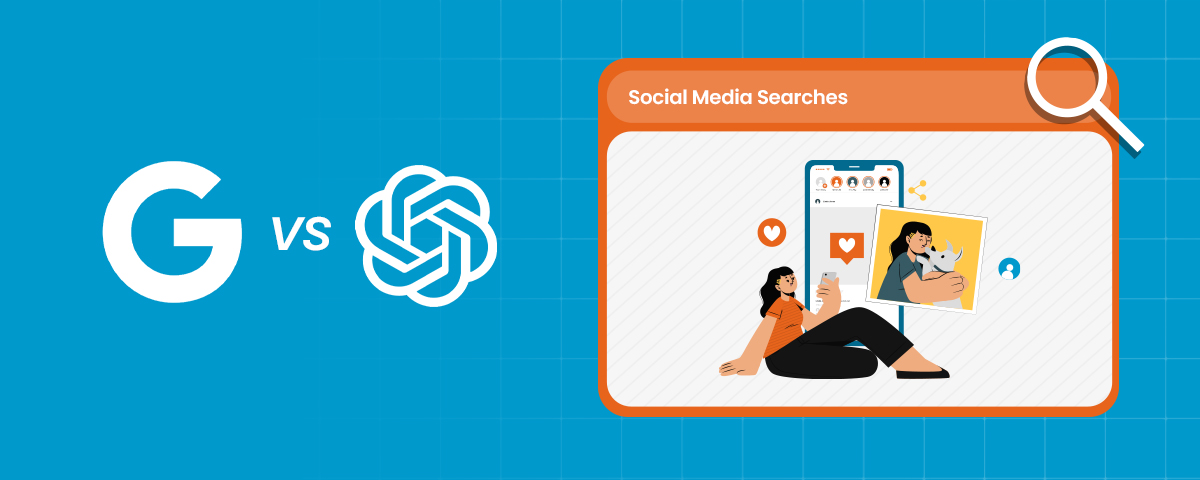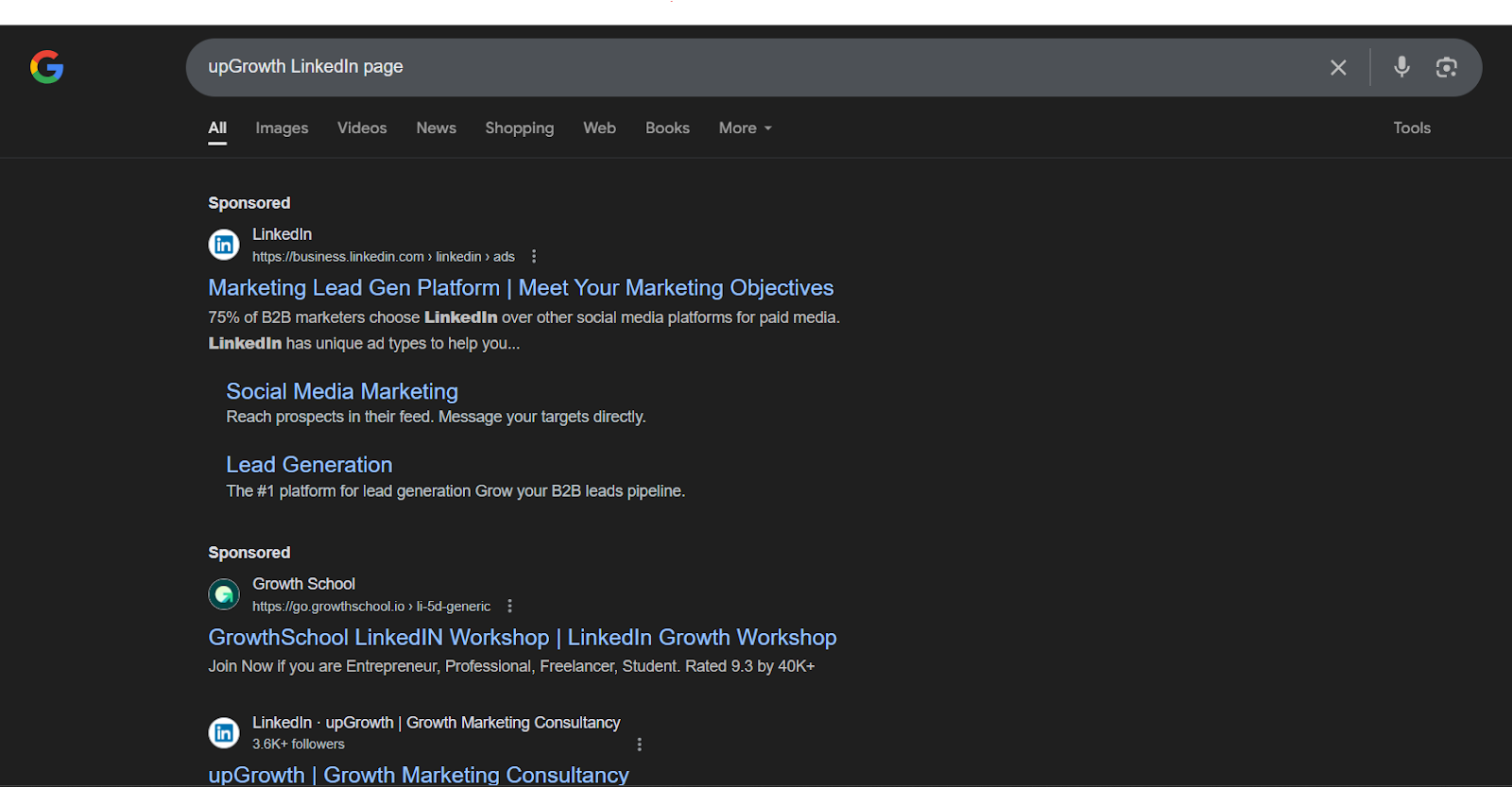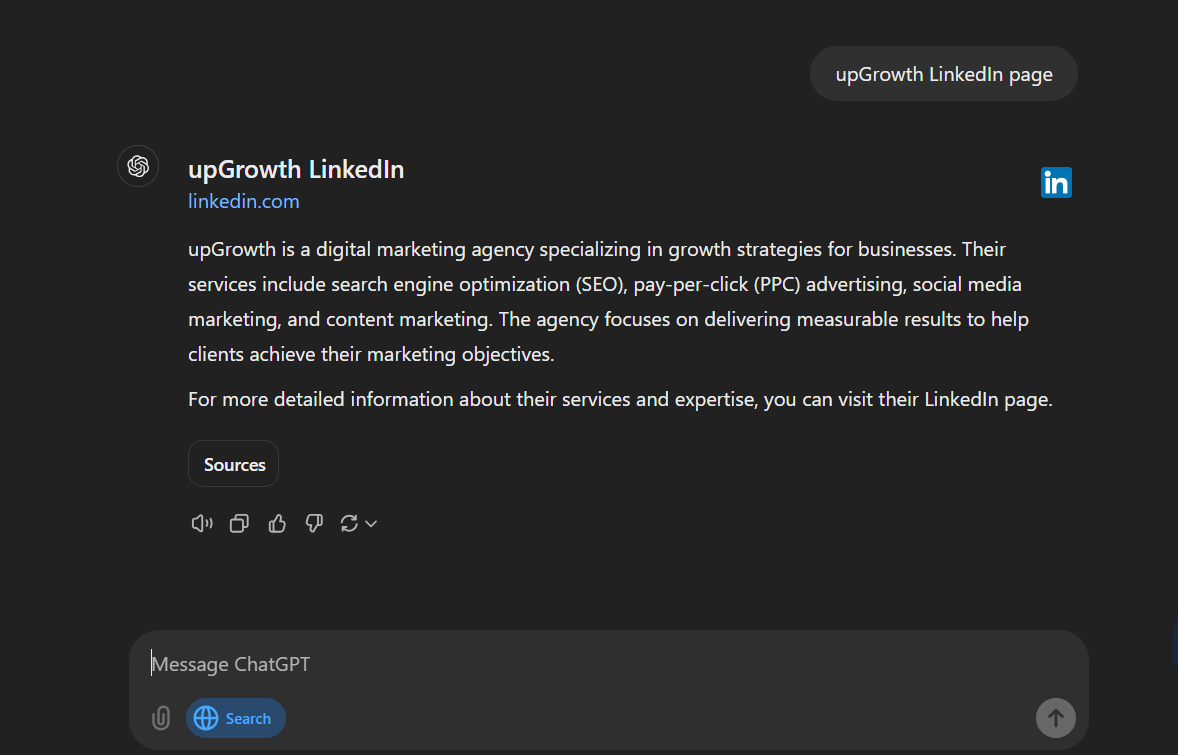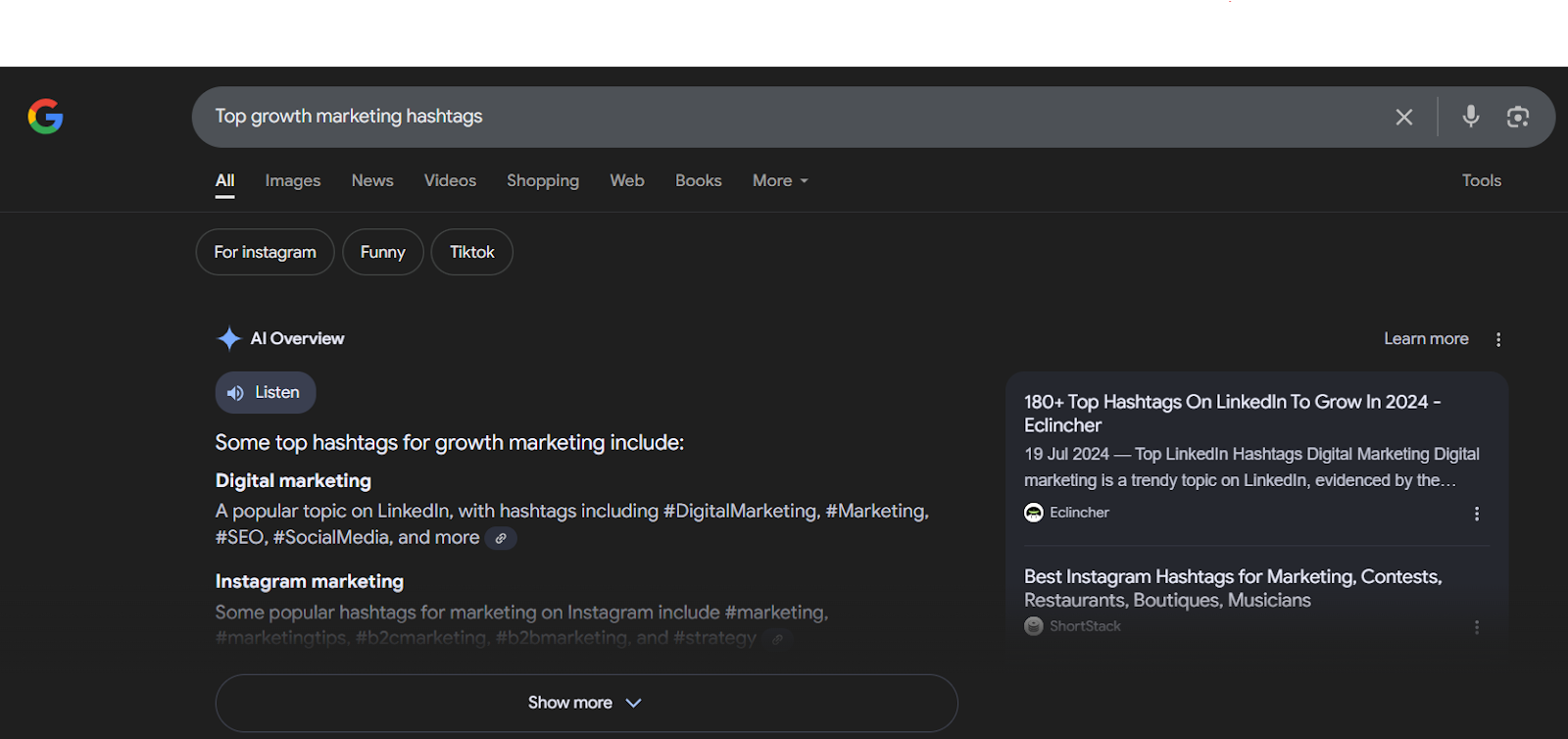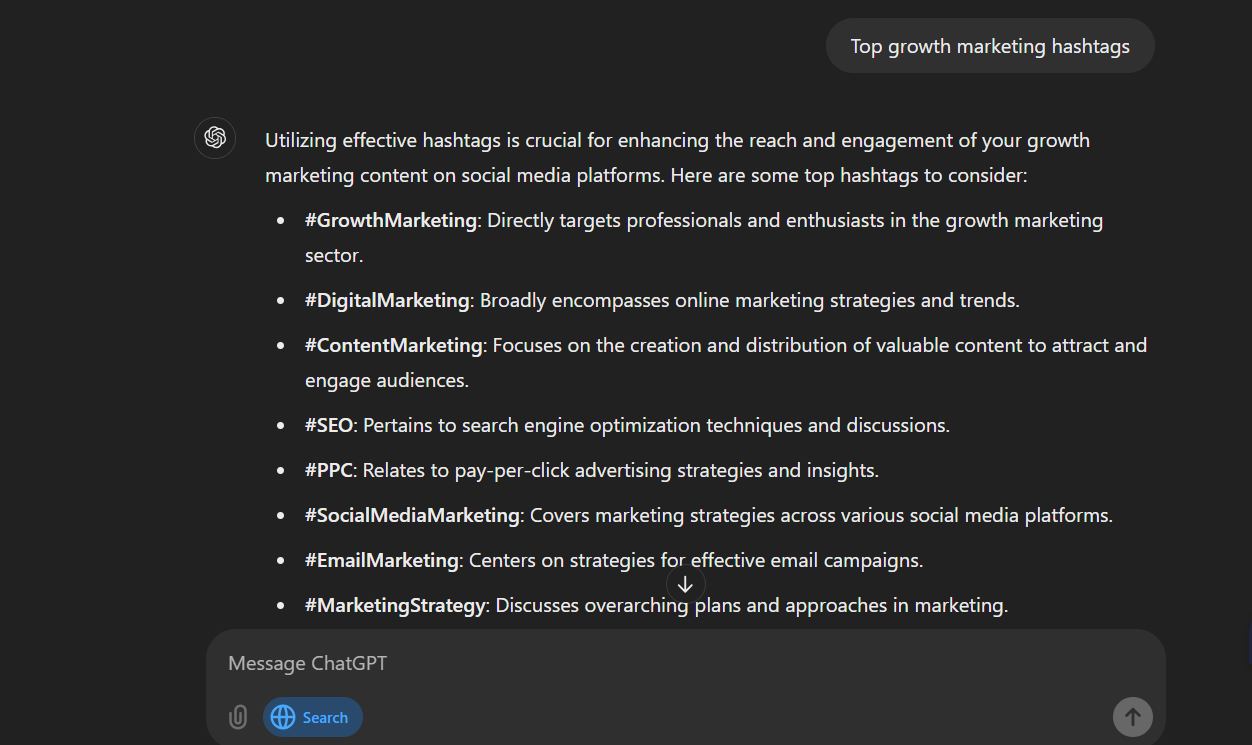Introduction
Social media has become a vital part of how users and businesses engage with trends, news, and brand interactions, making social media searches increasingly important. Users now rely on search engines not only to find traditional web content but also to access and analyse social media posts, profiles, and discussions.
Google and SearchGPT differ significantly in their approaches to social media-related queries: while Google integrates results from various social platforms and news sources, SearchGPT offers conversational summaries and recommendations. In this blog, we’ll explore these differences and include screenshots of the interfaces to better illustrate how each platform addresses social media searches.
What are Social Media Searches?
Social media searches refer to the process of looking up content, profiles, or discussions on social platforms to stay updated on trends, find specific accounts, or gather inspiration for content creation. These searches are essential for both individuals and businesses to track popular topics, monitor brand mentions, or identify potential content ideas.
Google and SearchGPT have emerged as powerful tools to facilitate these searches, each with a distinct approach. Google excels in aggregating results from various social media sites, displaying links to trending posts, public profiles, and news articles that reference social discussions.
In contrast, SearchGPT offers a conversational method, summarising key trends or recommending relevant social media accounts and hashtags. This makes Google ideal for comprehensive exploration, while SearchGPT is suited for quick insights and tailored recommendations.
Searching for Social Media Trends or Specific Profiles
Example Query: “upGrowth LinkedIn page”
Google Approach:
When users search for “upGrowth LinkedIn page”, Google typically presents direct links to the social media profile, often enhanced with rich snippets displaying additional information like profile images or short descriptions. These results usually appear at the top of the page, making it easy for users to access the desired social media page with a single click.
- Strengths:
Google’s ability to link directly to social media profiles provides users with quick and easy access to official pages and verified accounts, minimising the time needed to find the right source.
- Weaknesses:
In cases where profile names are similar or there are multiple entities with the same name, Google may include unrelated results, which could require further filtering.
SearchGPT Approach:
SearchGPT handles a query like “upGrowth LinkedIn page” by offering a descriptive response. This might include information about the company’s LinkedIn content focus, such as “upGrowth’s LinkedIn page shares insights on digital marketing strategies and industry trends”. While this helps users identify the correct profile, it doesn’t link directly to the page, requiring users to manually search for it afterwards.
- Strengths:
SearchGPT’s responses are context-rich and can help users confirm they are searching for the correct profile by including details about the type of content shared and the profile’s general focus.
- Weaknesses:
The lack of direct links means that users need to take extra steps to locate the profile on their own, which can slow down the process for those seeking immediate access.
Comparison Summary:
The main difference in user experience between Google and SearchGPT for social media searches lies in how users access the content. Google’s interface excels in offering quick, direct links, making it simple to find and visit specific profiles. SearchGPT, however, provides a more descriptive overview, helping users identify and understand the type of content available but requiring an additional step to access the profile. This highlights Google’s strength in immediacy versus SearchGPT’s contextual approach.
Searching for Social Media Content Ideas
Example Query: “Top growth marketing hashtags”
Google Approach:
When users search for “Top growth marketing hashtags”, Google returns a variety of blog articles, tools, and curated lists that generate trending hashtags and content ideas. These results often come from reputable marketing websites, social media trend trackers, and list-based articles. Users can explore various links to find the most relevant and comprehensive insights.
- Strengths:
Google’s strength lies in offering access to a broad range of resources. Users can find in-depth articles, expert opinions, and specialised tools that help them generate content ideas or find trending hashtags tailored to their niche.
- Weaknesses:
The multitude of links and resources can be overwhelming. Users often need to click through multiple pages to gather sufficient information, which can be time-consuming and lead to decision fatigue.
SearchGPT Approach:
SearchGPT responds to queries like “Top growth marketing hashtags” by directly listing popular hashtags or suggesting related content themes. For instance, it might reply with: “Current trending hashtags in growth marketing include #GrowthHacking, #DigitalMarketingTrends, and #CustomerAcquisition.” This approach saves users time by delivering concise, actionable suggestions without requiring additional navigation.
- Strengths:
SearchGPT provides a straightforward and efficient way to access trending hashtags or content ideas. Users benefit from a quick overview that doesn’t necessitate browsing multiple sites or dealing with information overload.
- Weaknesses:
While SearchGPT offers simplicity, it may not provide detailed context on why a specific hashtag is trending or cite its source. Users looking for deeper insights into the popularity and performance of each hashtag may need to supplement their search elsewhere.
Comparison Summary:
Google and SearchGPT offer different experiences when searching for social media content ideas. Google excels at providing a variety of sources and detailed context, making it ideal for users who want a comprehensive overview and in-depth research. In contrast, SearchGPT is perfect for those who need quick, simple content ideas without navigating through multiple sites. This showcases Google’s strength in depth and breadth versus SearchGPT’s advantage in delivering fast, actionable results.
User Preferences and Use Cases
When it comes to social media searches, user preferences and use cases play a key role in choosing between Google and SearchGPT. Each tool has strengths suited to different scenarios and user needs.
Google Use Cases
- Direct Links to Social Media Profiles: For users seeking official social media pages or specific profiles, Google is the better option. A search like “upGrowth LinkedIn page” provides immediate access through direct links, rich snippets, and profile previews, enabling users to visit verified accounts without additional steps.
- Detailed Blog Posts and In-Depth Content Ideas: Users researching social media strategies or looking for comprehensive resources on content ideas will find Google more suitable. Searching for “top growth marketing hashtags” yields a variety of articles, expert opinions, and curated lists that offer detailed context and analysis, perfect for users who need in-depth understanding and multiple perspectives.
SearchGPT Use Cases
- Quick Overview of Social Media Trends: SearchGPT is ideal for users who want immediate, no-frills answers. A query like “current top marketing hashtags” can yield a straightforward list of popular hashtags or a brief summary of trends, saving users time and effort.
- Immediate Content Suggestions: For individuals or marketers needing quick inspiration, SearchGPT provides concise content ideas in a conversational format. It’s perfect for users on the go or those who want a rapid start without navigating through extensive articles or tools.
Comparison Summary:
Google and SearchGPT cater to different user needs in social media searches. Google excels when users require detailed information, multiple sources, and direct access to social media pages, making it perfect for thorough research. SearchGPT, on the other hand, is best suited for users who value quick, efficient overviews and simple content suggestions without the need for extensive browsing.
Key Differences in User Experience
The user experience of searching for social media content through Google and SearchGPT varies significantly, particularly in profile access, depth versus simplicity, and the availability of visual elements and direct links.
Profile Access vs. Context
Google: When users search for social media profiles, Google offers direct links that make accessing official pages easy and straightforward. For example, a search like “upGrowth LinkedIn page” typically appears at the top of the search results with rich snippets, allowing users to click and visit the profile instantly.
SearchGPT: Instead of linking directly to profiles, SearchGPT provides context-based recommendations, such as descriptions of what users might find on the page. This helps users confirm they are looking for the right profile but requires an extra step to access it.
Depth vs. Simplicity
Google for Depth: Google’s search results offer a comprehensive range of sources, including blog posts, detailed articles, and tools, making it perfect for users who need thorough research or multiple perspectives on social media trends or content ideas.
SearchGPT for Simplicity: SearchGPT excels at providing users with simple, actionable ideas in a conversational format. For example, if a user asks for “top marketing hashtags”, SearchGPT will deliver a direct list without the need to browse through several pages or sites.
Visual and Direct Links
Google’s Rich Snippets and Direct Links: Google enhances user experience with rich snippets that include profile images and summaries, along with clickable links. This visual and interactive approach allows users to instantly identify and visit the desired social media page or explore related resources.
SearchGPT’s Conversational Approach: SearchGPT lacks visual previews and direct links, focusing instead on text-based, context-rich responses. While this approach offers clear, informative recommendations, users need to take further action to locate and view content on other platforms.
Comparison Summary:
Google’s user experience is built for those who prioritise detailed resources, visual aids, and instant access through direct links, making it ideal for deep dives into social media content. SearchGPT, however, provides a simpler, quicker path to actionable ideas and contextual information, catering to users who prefer concise, immediate responses over extensive navigation.
Visual Interface Comparison
The visual presentation of search results in Google and SearchGPT creates distinct experiences for users searching for social media pages and content ideas, each affecting user decision-making in unique ways.
Google’s Search Results Interface
Google’s search results for social media pages and content suggestions are highly visual and interactive. When searching for a query like “upGrowth LinkedIn page”, Google often displays rich snippets that include profile images, a brief description, and clickable links to the social media profile, allowing users to access official pages immediately. For content-related searches, such as “top marketing hashtags”, Google provides a list of curated articles, blog posts, and tool recommendations that give users multiple options to explore.
Impact on User Experience and Decision-Making:
Google’s interface is ideal for users who rely on visual cues and appreciate a variety of content sources to choose from. The presence of direct links and rich snippets makes it easy for users to identify and access the exact social media page or article they need, facilitating quick decision-making. However, the abundance of options can sometimes be overwhelming for users looking for a more streamlined answer.
SearchGPT’s Conversational Responses
SearchGPT’s approach to social media searches is text-based and conversational. When a user queries something like “top marketing hashtags”, SearchGPT provides a brief, direct list of popular hashtags or simple content ideas without requiring additional navigation. For profile searches, such as “upGrowth LinkedIn page”, SearchGPT might give a short description of the profile and its content focus but lacks direct links to the page.
Impact on User Experience and Decision-Making:
SearchGPT’s conversational format is designed for simplicity and speed, making it well-suited for users who want quick insights or actionable ideas without sifting through multiple pages. However, the lack of visual elements and direct links means users need to perform an additional search if they want to access a specific profile or more detailed resources, which may slow down decision-making for those requiring immediate access.
Comparison Summary:
Google’s visually rich, direct-link interface supports a detailed, choice-driven search experience, making it ideal for users who value comprehensive resources and instant access. In contrast, SearchGPT’s text-based responses provide efficient, no-frills guidance, perfect for users who prioritise a fast, straightforward answer. These differences highlight Google’s advantage in visual engagement and direct accessibility, while SearchGPT shines in offering concise, conversational support.
Final Verdict: SearchGPT vs. Google for Social Media Searches
Google and SearchGPT each offer distinct advantages for social media searches, catering to different user needs. Google stands out with its visually rich results, direct links to social media profiles, and access to comprehensive resources, making it ideal for users seeking in-depth exploration and quick profile access.
In contrast, SearchGPT excels in delivering fast, concise responses and actionable content suggestions, perfect for users looking for immediate insights or trend summaries without navigating multiple pages.
Ultimately, the choice between Google and SearchGPT depends on user goals. Whether you need detailed options and direct access or a simplified overview and quick ideas, both tools bring valuable strengths to social media searches.
Mastering the Future of Search and Marketing
At upGrowth, we are committed to helping businesses and individuals stay ahead in digital marketing and search technology. By offering insights and strategies tailored to emerging tools like SearchGPT and trusted platforms like Google, we empower our audience to make informed decisions that enhance their online presence. Dive into our blog series to explore how to optimise your strategies for various search types and harness the best of both AI-driven and traditional search engines.
Searching for Social Media Trends or Specific Profiles
Example Query: “upGrowth LinkedIn page”
Google Approach:
When users search for “upGrowth LinkedIn page”, Google typically presents direct links to the social media profile, often enhanced with rich snippets displaying additional information like profile images or short descriptions. These results usually appear at the top of the page, making it easy for users to access the desired social media page with a single click.
- Strengths:
Google’s ability to link directly to social media profiles provides users with quick and easy access to official pages and verified accounts, minimising the time needed to find the right source.
- Weaknesses:
In cases where profile names are similar or there are multiple entities with the same name, Google may include unrelated results, which could require further filtering.
SearchGPT Approach:
SearchGPT handles a query like “upGrowth LinkedIn page” by offering a descriptive response. This might include information about the company’s LinkedIn content focus, such as “upGrowth’s LinkedIn page shares insights on digital marketing strategies and industry trends”. While this helps users identify the correct profile, it doesn’t link directly to the page, requiring users to manually search for it afterwards.
- Strengths:
SearchGPT’s responses are context-rich and can help users confirm they are searching for the correct profile by including details about the type of content shared and the profile’s general focus.
- Weaknesses:
The lack of direct links means that users need to take extra steps to locate the profile on their own, which can slow down the process for those seeking immediate access.
Comparison Summary:
The main difference in user experience between Google and SearchGPT for social media searches lies in how users access the content. Google’s interface excels in offering quick, direct links, making it simple to find and visit specific profiles. SearchGPT, however, provides a more descriptive overview, helping users identify and understand the type of content available but requiring an additional step to access the profile. This highlights Google’s strength in immediacy versus SearchGPT’s contextual approach.
Searching for Social Media Content Ideas
Example Query: “Top growth marketing hashtags”
Google Approach:
When users search for “Top growth marketing hashtags”, Google returns a variety of blog articles, tools, and curated lists that generate trending hashtags and content ideas. These results often come from reputable marketing websites, social media trend trackers, and list-based articles. Users can explore various links to find the most relevant and comprehensive insights.
- Strengths:
Google’s strength lies in offering access to a broad range of resources. Users can find in-depth articles, expert opinions, and specialised tools that help them generate content ideas or find trending hashtags tailored to their niche.
- Weaknesses:
The multitude of links and resources can be overwhelming. Users often need to click through multiple pages to gather sufficient information, which can be time-consuming and lead to decision fatigue.
SearchGPT Approach:
SearchGPT responds to queries like “Top growth marketing hashtags” by directly listing popular hashtags or suggesting related content themes. For instance, it might reply with: “Current trending hashtags in growth marketing include #GrowthHacking, #DigitalMarketingTrends, and #CustomerAcquisition.” This approach saves users time by delivering concise, actionable suggestions without requiring additional navigation.
- Strengths:
SearchGPT provides a straightforward and efficient way to access trending hashtags or content ideas. Users benefit from a quick overview that doesn’t necessitate browsing multiple sites or dealing with information overload.
- Weaknesses:
While SearchGPT offers simplicity, it may not provide detailed context on why a specific hashtag is trending or cite its source. Users looking for deeper insights into the popularity and performance of each hashtag may need to supplement their search elsewhere.
Comparison Summary:
Google and SearchGPT offer different experiences when searching for social media content ideas. Google excels at providing a variety of sources and detailed context, making it ideal for users who want a comprehensive overview and in-depth research. In contrast, SearchGPT is perfect for those who need quick, simple content ideas without navigating through multiple sites. This showcases Google’s strength in depth and breadth versus SearchGPT’s advantage in delivering fast, actionable results.
User Preferences and Use Cases
When it comes to social media searches, user preferences and use cases play a key role in choosing between Google and SearchGPT. Each tool has strengths suited to different scenarios and user needs.
Google Use Cases
- Direct Links to Social Media Profiles: For users seeking official social media pages or specific profiles, Google is the better option. A search like “upGrowth LinkedIn page” provides immediate access through direct links, rich snippets, and profile previews, enabling users to visit verified accounts without additional steps.
- Detailed Blog Posts and In-Depth Content Ideas: Users researching social media strategies or looking for comprehensive resources on content ideas will find Google more suitable. Searching for “top growth marketing hashtags” yields a variety of articles, expert opinions, and curated lists that offer detailed context and analysis, perfect for users who need in-depth understanding and multiple perspectives.
SearchGPT Use Cases
- Quick Overview of Social Media Trends: SearchGPT is ideal for users who want immediate, no-frills answers. A query like “current top marketing hashtags” can yield a straightforward list of popular hashtags or a brief summary of trends, saving users time and effort.
- Immediate Content Suggestions: For individuals or marketers needing quick inspiration, SearchGPT provides concise content ideas in a conversational format. It’s perfect for users on the go or those who want a rapid start without navigating through extensive articles or tools.
Comparison Summary:
Google and SearchGPT cater to different user needs in social media searches. Google excels when users require detailed information, multiple sources, and direct access to social media pages, making it perfect for thorough research. SearchGPT, on the other hand, is best suited for users who value quick, efficient overviews and simple content suggestions without the need for extensive browsing.
Key Differences in User Experience
The user experience of searching for social media content through Google and SearchGPT varies significantly, particularly in profile access, depth versus simplicity, and the availability of visual elements and direct links.
Profile Access vs. Context
Google: When users search for social media profiles, Google offers direct links that make accessing official pages easy and straightforward. For example, a search like “upGrowth LinkedIn page” typically appears at the top of the search results with rich snippets, allowing users to click and visit the profile instantly.
SearchGPT: Instead of linking directly to profiles, SearchGPT provides context-based recommendations, such as descriptions of what users might find on the page. This helps users confirm they are looking for the right profile but requires an extra step to access it.
Depth vs. Simplicity
Google for Depth: Google’s search results offer a comprehensive range of sources, including blog posts, detailed articles, and tools, making it perfect for users who need thorough research or multiple perspectives on social media trends or content ideas.
SearchGPT for Simplicity: SearchGPT excels at providing users with simple, actionable ideas in a conversational format. For example, if a user asks for “top marketing hashtags”, SearchGPT will deliver a direct list without the need to browse through several pages or sites.
Visual and Direct Links
Google’s Rich Snippets and Direct Links: Google enhances user experience with rich snippets that include profile images and summaries, along with clickable links. This visual and interactive approach allows users to instantly identify and visit the desired social media page or explore related resources.
SearchGPT’s Conversational Approach: SearchGPT lacks visual previews and direct links, focusing instead on text-based, context-rich responses. While this approach offers clear, informative recommendations, users need to take further action to locate and view content on other platforms.
Comparison Summary:
Google’s user experience is built for those who prioritise detailed resources, visual aids, and instant access through direct links, making it ideal for deep dives into social media content. SearchGPT, however, provides a simpler, quicker path to actionable ideas and contextual information, catering to users who prefer concise, immediate responses over extensive navigation.
Visual Interface Comparison
The visual presentation of search results in Google and SearchGPT creates distinct experiences for users searching for social media pages and content ideas, each affecting user decision-making in unique ways.
Google’s Search Results Interface
Google’s search results for social media pages and content suggestions are highly visual and interactive. When searching for a query like “upGrowth LinkedIn page”, Google often displays rich snippets that include profile images, a brief description, and clickable links to the social media profile, allowing users to access official pages immediately. For content-related searches, such as “top marketing hashtags”, Google provides a list of curated articles, blog posts, and tool recommendations that give users multiple options to explore.
Impact on User Experience and Decision-Making:
Google’s interface is ideal for users who rely on visual cues and appreciate a variety of content sources to choose from. The presence of direct links and rich snippets makes it easy for users to identify and access the exact social media page or article they need, facilitating quick decision-making. However, the abundance of options can sometimes be overwhelming for users looking for a more streamlined answer.
SearchGPT’s Conversational Responses
SearchGPT’s approach to social media searches is text-based and conversational. When a user queries something like “top marketing hashtags”, SearchGPT provides a brief, direct list of popular hashtags or simple content ideas without requiring additional navigation. For profile searches, such as “upGrowth LinkedIn page”, SearchGPT might give a short description of the profile and its content focus but lacks direct links to the page.
Impact on User Experience and Decision-Making:
SearchGPT’s conversational format is designed for simplicity and speed, making it well-suited for users who want quick insights or actionable ideas without sifting through multiple pages. However, the lack of visual elements and direct links means users need to perform an additional search if they want to access a specific profile or more detailed resources, which may slow down decision-making for those requiring immediate access.
Comparison Summary:
Google’s visually rich, direct-link interface supports a detailed, choice-driven search experience, making it ideal for users who value comprehensive resources and instant access. In contrast, SearchGPT’s text-based responses provide efficient, no-frills guidance, perfect for users who prioritise a fast, straightforward answer. These differences highlight Google’s advantage in visual engagement and direct accessibility, while SearchGPT shines in offering concise, conversational support.
Final Verdict: SearchGPT vs. Google for Social Media Searches
Google and SearchGPT each offer distinct advantages for social media searches, catering to different user needs. Google stands out with its visually rich results, direct links to social media profiles, and access to comprehensive resources, making it ideal for users seeking in-depth exploration and quick profile access.
In contrast, SearchGPT excels in delivering fast, concise responses and actionable content suggestions, perfect for users looking for immediate insights or trend summaries without navigating multiple pages.
Ultimately, the choice between Google and SearchGPT depends on user goals. Whether you need detailed options and direct access or a simplified overview and quick ideas, both tools bring valuable strengths to social media searches.
Mastering the Future of Search and Marketing
At upGrowth, we are committed to helping businesses and individuals stay ahead in digital marketing and search technology. By offering insights and strategies tailored to emerging tools like SearchGPT and trusted platforms like Google, we empower our audience to make informed decisions that enhance their online presence. Dive into our blog series to explore how to optimise your strategies for various search types and harness the best of both AI-driven and traditional search engines.

